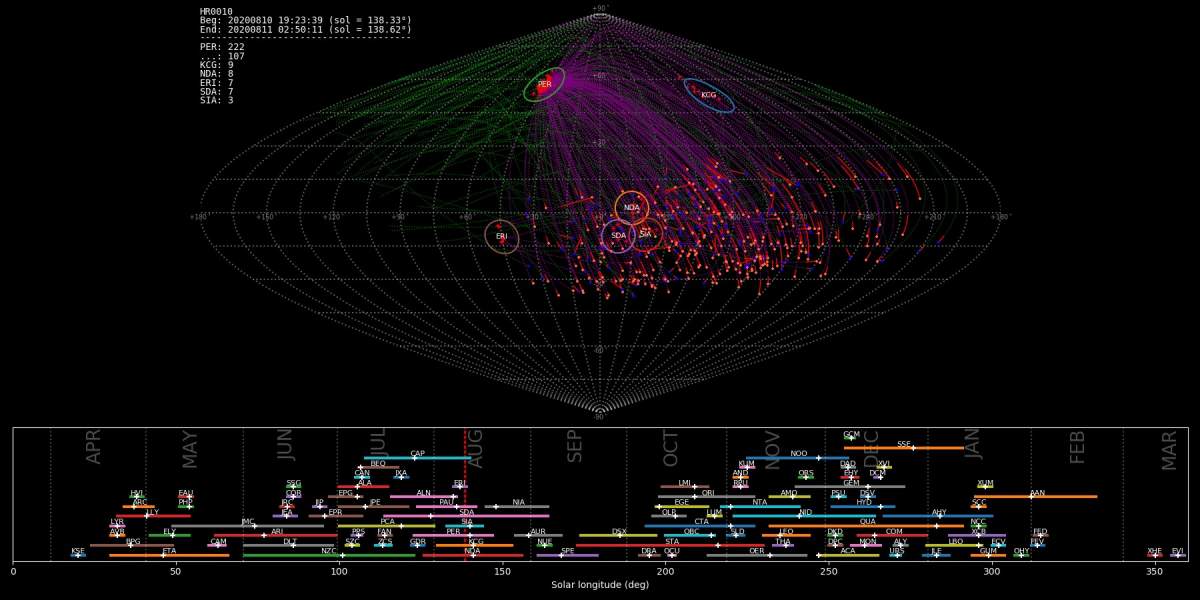Stargazers in the northern hemisphere can expect a treat this weekend as the peak of the Perseid meteor shower nearly coincides with the new moon, making the backdrop of the light show especially dark.

Just going outside and looking up will be enough to see the show Saturday night and Sunday morning, but for the best viewing experience, the Global Meteor Network has some tips.
The darker the better
“The best place to see is somewhere where there’s very little light,” says Denis Vida, project lead and a meteor physics group postdoctoral associate at Western University in London, Ont., where the Global Meteor Network is based.
Vida suggests turning your phone off and avoiding any bright lights for at least 10 minutes before you turn your gaze to the sky.
“This is how long it’s going to take for your eyes to adjust to darkness. And if you look at your phone or anything bright, you will lose your night vision. So only then you will be able to really fully appreciate the stars and the number of meteors that you see.”
Luckily, this year, the Perseids coincide with the darkest lunar phase.
“Just a couple of days after the peak of the Perseids, we’re going to have the new moon, which means that the moon is going to be completely absent in the night sky. So last year we had the full moon and the Perseids were more or less washed out,” Vida explains.
“From year to year, the moon conditions change and of course, the weather conditions change, so it’s not every year that you can see them quite as well as this year.”
Look for the radiant
A meteor shower basically involves numerous meteors “coming from the same apparent source in the sky,” called the “radiant,” Vida says.
The Perseid meteor shower is so named because the radiant — the point where the meteors appear to be originating from — is in the constellation Perseus.
“You can see the Perseids anywhere in the night sky, but the best location is usually around 45 degrees off radiant,” said Vida.
Fortunately, 45 degrees off the radiant will take your eye to one of the most well-known constellations: the Big Dipper.

Get breaking National news
“If you see the Big Dipper, that is about 45 degrees off the Perseid radiant and probably the best place to observe, if you can see that in the night sky. But, really, anywhere in the night sky is fine.”
Find the right time
The Perseid meteor shower lasts about two weeks, with the peak viewing period this year happening this weekend.
More specifically, the best time to view would be after 10 p.m. Saturday, Aug. 12 and before 3 a.m. Sunday, Aug. 13 when the waning crescent moon rises.
The Global Meteor Network is making it even easier to see if it is prime viewing for meteors with its new website.
On the Meteor Shower Flux Monitoring page, the GMN is providing a dial to show how many meteors a viewer can expect to see per hour under ideal conditions in the next 24 hours.
“If the needle is in blue, which means there is very little meteor activity, if you go out, you’re not going to see much. But if the needle goes through green to red, you know there’s going to be high meteor shower activity and it’s probably a good time to watch,” Vida says.
“This dial is very handy for the general public but the hard numbers that are below on the website are what’s interesting to NASA and of course, us, because we use past observations to make forecasts in the future. So we literally are working on predicting space weather.”
However, the Perseids can sometimes have unexpected bursts of activity, like in 2021 when, for a couple of hours, there was an unexpected peak of up to 300 meteors per hour or roughly three times the typical peak viewing rate.
More about meteors
It can put on quite a light show but the majority of meteors are actually only about the size of a grain of sand.
The particles enter Earth’s atmosphere at “hypersonic speeds,” or about 60 kilometres per second.
“Not 60 km an hour, but per second,” Vida stressed, explaining that the particles travel so fast that they ionize the air around them and stay “literally vaporized.”
“The energy is so hot that it can vaporize rock and this is what we see as meteors. The Perseids are an old meteor shower tens of thousands of years old and you could see them for tens of thousands of years and we do have historical records showing that.”

While tiny, meteors can be dangerous, putting astronauts at a one-in-5,000 risk of death during a typical eight-hour spacewalk.
“This is literally a tiny dust particle that is travelling so fast it has the same kinetic energy as a bullet. It would create a little hole in the spacesuit they wouldn’t be able to find in time and unfortunately, the astronaut would pass away,” he explained.
“That is during the period of nominal meteor activity when there are no major meteor showers active.”
During a shower, when there could be hundreds or thousands of meteors per hour, “your chances are more or less guaranteed that something bad is going to happen.”
The GMN monitors meteor showers in order to make accurate predictions and provide that data to NASA so it can plan its space missions.
The GMN, established in 2018, is based out of Western University and involves “mostly amateur astronomers” but also professional astronomers worldwide sharing data from roughly 1,000 “very cheap, consumer-grade security cameras.”
“Instead of pointing them down, they just simply point them up,” Vida says.
“They run our open source software that does almost everything automatically, detects meteors, does all the measurements, and reports them back to Western,” which then crunches the numbers for NASA.














Comments